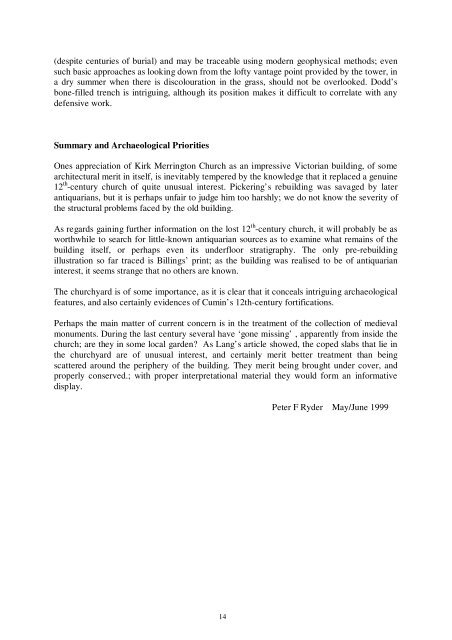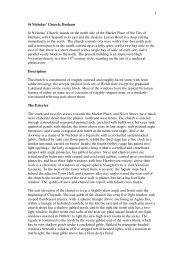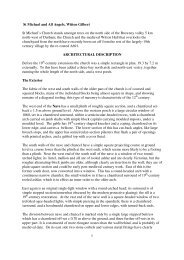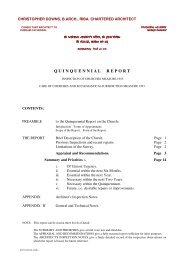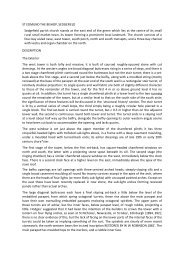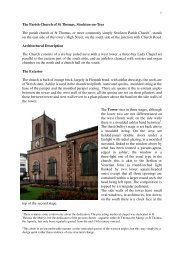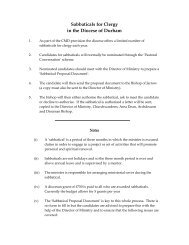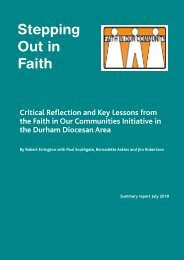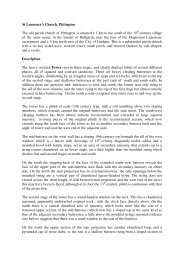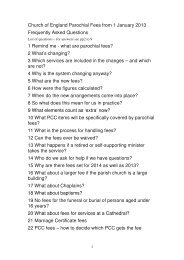St John the Evangelist, Kirk Merrington The parish church of Kirk ...
St John the Evangelist, Kirk Merrington The parish church of Kirk ...
St John the Evangelist, Kirk Merrington The parish church of Kirk ...
Create successful ePaper yourself
Turn your PDF publications into a flip-book with our unique Google optimized e-Paper software.
(despite centuries <strong>of</strong> burial) and may be traceable using modern geophysical methods; even<br />
such basic approaches as looking down from <strong>the</strong> l<strong>of</strong>ty vantage point provided by <strong>the</strong> tower, in<br />
a dry summer when <strong>the</strong>re is discolouration in <strong>the</strong> grass, should not be overlooked. Dodd’s<br />
bone-filled trench is intriguing, although its position makes it difficult to correlate with any<br />
defensive work.<br />
Summary and Archaeological Priorities<br />
Ones appreciation <strong>of</strong> <strong>Kirk</strong> <strong>Merrington</strong> Church as an impressive Victorian building, <strong>of</strong> some<br />
architectural merit in itself, is inevitably tempered by <strong>the</strong> knowledge that it replaced a genuine<br />
12 th -century <strong>church</strong> <strong>of</strong> quite unusual interest. Pickering’s rebuilding was savaged by later<br />
antiquarians, but it is perhaps unfair to judge him too harshly; we do not know <strong>the</strong> severity <strong>of</strong><br />
<strong>the</strong> structural problems faced by <strong>the</strong> old building.<br />
As regards gaining fur<strong>the</strong>r information on <strong>the</strong> lost 12 th -century <strong>church</strong>, it will probably be as<br />
worthwhile to search for little-known antiquarian sources as to examine what remains <strong>of</strong> <strong>the</strong><br />
building itself, or perhaps even its underfloor stratigraphy. <strong>The</strong> only pre-rebuilding<br />
illustration so far traced is Billings’ print; as <strong>the</strong> building was realised to be <strong>of</strong> antiquarian<br />
interest, it seems strange that no o<strong>the</strong>rs are known.<br />
<strong>The</strong> <strong>church</strong>yard is <strong>of</strong> some importance, as it is clear that it conceals intriguing archaeological<br />
features, and also certainly evidences <strong>of</strong> Cumin’s 12th-century fortifications.<br />
Perhaps <strong>the</strong> main matter <strong>of</strong> current concern is in <strong>the</strong> treatment <strong>of</strong> <strong>the</strong> collection <strong>of</strong> medieval<br />
monuments. During <strong>the</strong> last century several have ‘gone missing’ , apparently from inside <strong>the</strong><br />
<strong>church</strong>; are <strong>the</strong>y in some local garden? As Lang’s article showed, <strong>the</strong> coped slabs that lie in<br />
<strong>the</strong> <strong>church</strong>yard are <strong>of</strong> unusual interest, and certainly merit better treatment than being<br />
scattered around <strong>the</strong> periphery <strong>of</strong> <strong>the</strong> building. <strong>The</strong>y merit being brought under cover, and<br />
properly conserved.; with proper interpretational material <strong>the</strong>y would form an informative<br />
display.<br />
Peter F Ryder May/June 1999<br />
14


